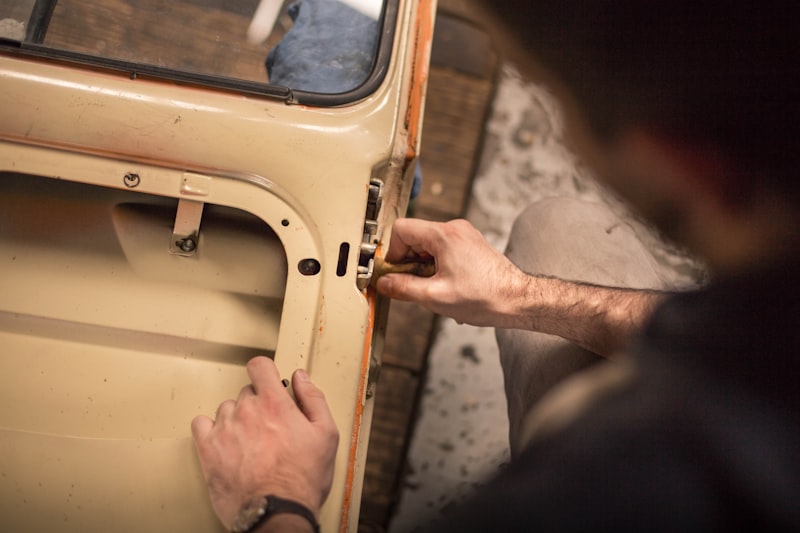Repairing a car’s differential can seem daunting, but with the right tips, you can tackle it effectively. First, diagnose the issue accurately by listening for unusual noises like whining or clunking sounds while driving. These could indicate worn-out bearings or gear damage. Once identified, gather the necessary tools—a socket set, jack stands, and a repair manual specific to your vehicle model.
Start by safely raising the car and securing it on jack stands. Remove the differential cover to inspect the gears and bearings. Look for signs of metal shavings or excessive wear, which may require replacement. Clean the components thoroughly using a solvent to remove old lubricant and debris.
Next, carefully remove the old gasket material from both the differential cover and housing to ensure a proper seal when reassembling. Use a scraper and solvent for this task. Inspect the gears for any chips or cracks, as these can lead to further problems if not addressed.
When replacing bearings or gears, ensure they match the specifications outlined in your repair manual. Apply a suitable gear lubricant recommended for your vehicle’s differential type. Proper lubrication is crucial to prevent overheating and premature wear.
Lastly, after reassembling the differential cover and securing it with the recommended torque settings, check for leaks and listen for any abnormal noises during a test drive. This step ensures that the repair was successful and that the differential functions smoothly.
Mastering the Mechanics: Essential Tips for DIY Differential Repair
Let’s break it down. Your car’s differential is like the unsung hero of your drivetrain. It’s what allows your wheels to rotate at different speeds while turning corners, ensuring smooth handling and preventing tire wear. Over time, though, differentials can develop leaks, wear out, or simply cry out for some TLC. That’s where your DIY spirit comes into play.
First off, before even touching a wrench, you’ll want to arm yourself with knowledge. Understanding how your specific differential works and its intricacies can save you from a world of frustration later on. Grab your car manual or hit up some reliable online resources for a crash course in Differential 101.
Next, gather your tools like a seasoned pro. A trusty socket set, torque wrench, jack stands, and of course, safety goggles are your best friends here. Nothing ruins a DIY party like a trip to the ER, right?
Once you’re prepped and feeling like a bona fide gearhead, it’s time to get hands-on. Start by carefully removing the differential cover and draining the fluid into a catch pan. This is where you might encounter that “aha!” moment—those metal shavings or funky smells could clue you in on potential issues lurking within.
Inspecting the gears and bearings is crucial—think of it like a detective combing through clues. Look for wear patterns, cracks, or any signs of distress. Depending on what you find, it might be a straightforward fix or a deeper dive into replacement territory.
Ah, but don’t forget the golden rule of DIY differential repair: cleanliness is next to gearliness (okay, we might have made that word up). Keeping everything squeaky clean and using the right lubricants can extend the life of your repairs and keep your differential humming along smoothly.
Your Guide to Troubleshooting and Fixing Car Differential Issues
First things first, diagnosing a differential problem involves keen observation. Are you hearing any unusual noises, such as whining, grinding, or clunking when you turn corners? These could indicate worn-out bearings or gears within the differential. Perhaps you’ve noticed leaks from the differential housing, which may point to a faulty seal or gasket. Additionally, if your vehicle experiences vibration or shuddering during acceleration or deceleration, it could be a sign of improper gear meshing or worn-out components.
Before diving into complex repairs, conduct some basic checks. Start by inspecting the differential fluid level and condition. Low fluid levels or dirty fluid can lead to inadequate lubrication and cause excessive wear. Next, check for any leaks around the differential housing and axle seals. Addressing leaks promptly can prevent more serious damage to internal components.
If you’re comfortable with DIY repairs, changing differential fluid and replacing seals are tasks you can tackle with basic tools. However, for more intricate issues like bearing or gear replacements, it’s advisable to consult a professional mechanic. They have the expertise and tools to dismantle the differential, diagnose the exact problem, and execute repairs accurately.
Regular maintenance goes a long way in preventing differential problems. Follow your vehicle manufacturer’s recommended service intervals for differential fluid changes and inspections. Keeping the differential properly lubricated and sealed can extend its lifespan and minimize the risk of costly repairs down the road.
By staying attentive to your car’s performance and addressing differential issues promptly, you can ensure smooth drives and avoid potential breakdowns. Whether you’re handling basic maintenance or seeking professional assistance, understanding the symptoms and causes of differential problems empowers you to make informed decisions. Remember, a well-maintained differential means a happier car and a safer ride for you!
Step-by-Step: How to Repair Your Car’s Differential Like a Pro
Ever wondered what makes your car smoothly cruise around corners? One crucial component playing a vital role is the differential. It’s like the traffic cop of your car’s axle system, ensuring each wheel gets just the right amount of power. Over time, this hardworking part can wear out or develop issues, affecting your car’s performance. But fear not! With a little know-how and the right tools, you can tackle differential repair like a seasoned pro.
First things first, diagnose what’s wrong with your differential. Is it making strange noises when you turn? Or perhaps there’s a leak? Identifying the issue will guide your repair process.
Repairing a differential requires a specific set of tools. You’ll typically need a jack and jack stands, a socket and wrench set, differential fluid, and possibly new gaskets or seals. Having everything ready beforehand saves time and frustration.
Safety is key here. Find a level surface and use your jack to lift the car, then secure it with jack stands. This gives you easy access to the differential.
Before diving into the internals, drain the old fluid from the differential. There’s usually a drain plug on the bottom. Let it drain completely before moving on.
With the fluid drained, it’s time to remove the differential cover. This may require loosening bolts around the perimeter. Once loose, carefully pry off the cover to reveal the gears inside.
Inspect the gears for wear or damage. Worn-out gears can cause whining noises or vibration. Replace any damaged parts as necessary, following your car’s repair manual for specifications.
Once repairs or replacements are done, clean the cover and differential housing surfaces. Apply a new gasket or sealant as recommended, then carefully reattach the cover. Tighten bolts evenly to ensure a proper seal.
With everything back in place, refill the differential with the recommended fluid. Use a funnel to prevent spills. This fluid is crucial for lubrication and heat dissipation.
Lower your car off the jack stands and take it for a spin. Listen for any unusual noises and pay attention to how it handles corners. A successful repair should restore smooth operation.
Repairing your car’s differential might seem daunting at first, but with patience and the right guidance, it’s a task within reach of any determined DIYer. By following these steps, you’ll not only save money but gain a deeper understanding of your vehicle’s inner workings. So, why not roll up your sleeves and give it a try?
Expert Advice: Common Differential Problems and How to Fix Them
Ever wondered what makes your car turn smoothly around corners? That’s the differential at work—a clever mechanism that allows your wheels to rotate at different speeds while cornering. However, when this crucial component malfunctions, it can lead to a bumpy ride. One of the telltale signs of a differential problem is strange noises emanating from your car’s undercarriage. Think of it as your car whispering a secret that something’s not quite right down there.
A frequent culprit behind differential troubles is low or contaminated differential fluid. This fluid is the lifeblood of your differential, ensuring all those gears mesh smoothly without grinding. Over time, it can break down or leak, causing increased friction and wear. Imagine trying to run a marathon without water—it’s a recipe for disaster. Similarly, neglecting differential fluid maintenance can lead to expensive repairs down the road.
Another common issue is worn-out differential bearings. These small but mighty components support the differential gears, allowing them to spin freely. When bearings wear out, they can produce a high-pitched whine or growl, signaling trouble in differential paradise. It’s like having a rock in your shoe—you can’t ignore it for long.
Now, let’s talk fixes. If you suspect differential problems, don’t wait for them to escalate into a full-blown breakdown. First off, check your differential fluid levels and condition regularly. It’s a simple task that can save you a heap of trouble. If the fluid is low or dirty, get it changed by a qualified technician. It’s like giving your car a refreshing drink to keep it running smoothly.
For more serious issues like worn bearings or damaged gears, it’s best to leave it to the pros. Differential repairs require specialized knowledge and tools, ensuring everything meshes perfectly once more. It’s like entrusting your car to a skilled surgeon—precision is key.
Understanding your car’s differential and addressing issues promptly can save you time, money, and a lot of headaches. So, next time you hear a suspicious noise from under your vehicle, don’t ignore it. Your differential might just be trying to tell you something important.
Save Money and Time: DIY Tips for Car Differential Repairs
Tackling car differential repairs on your own can save you both money and time, provided you approach it with the right knowledge and tools. The differential is a crucial component in your vehicle, responsible for transferring power from the engine to the wheels while allowing them to rotate at different speeds. Over time, it may develop issues like leaks, noisy operation, or even complete failure if not maintained properly.
One of the first steps in DIY differential repair is identifying the problem accurately. Is it a leaky seal, worn-out bearings, or something more serious? This requires careful inspection and possibly draining the differential fluid to check for metal shavings or unusual discoloration, indicating internal damage.
Once diagnosed, gather the necessary tools and parts before starting. Common tools include a socket set, torque wrench, and possibly specialized tools for bearing removal. Ensure you have the correct replacement parts as per your vehicle’s specifications.
Proceed with caution when disassembling the differential. Follow a repair manual or online guides specific to your car model. Remember, safety first—use jack stands and work in a well-lit, ventilated area. Cleanliness is crucial during reassembly to prevent contaminants from entering the differential.
A key DIY tip is to take your time and document each step. Photography or notes can help during reassembly, especially when dealing with multiple components. Don’t rush—precision ensures longevity and performance. Additionally, consider upgrading to high-quality differential fluids or reinforced parts for enhanced durability.
By tackling differential repairs yourself, you not only save on labor costs but also gain a deeper understanding of your vehicle’s mechanics. It’s a rewarding experience that empowers you as a car owner while ensuring your vehicle operates smoothly on the road.

This article aims to provide practical advice while maintaining a conversational tone, engaging the reader with actionable tips and emphasizing the benefits of DIY car maintenance.
Understanding Your Car’s Differential: Repair Tips for Every Driver
Have you ever wondered what makes your car handle smoothly around corners, especially on different road surfaces? One crucial component responsible for this is the differential. The differential is a mechanism that allows the outer wheels of your car to rotate faster than the inner wheels when turning, ensuring stability and control.

In simple terms, a differential is a gearbox located between the drive wheels of your vehicle. Its primary function is to distribute engine power evenly to the wheels while allowing them to rotate at different speeds, such as during turns. This not only improves traction but also enhances the overall handling and performance of your car.
There are several types of differentials used in modern vehicles, including open differentials, limited-slip differentials (LSD), and locking differentials. Each type has its own advantages depending on the driving conditions and vehicle type.
Like any mechanical component, differentials can experience issues over time. One of the most common problems is fluid leakage, which can lead to insufficient lubrication and eventual wear of internal components. Another issue is unusual noises such as whining or clunking, which may indicate worn-out bearings or gears.
Regular maintenance is key to ensuring your differential operates smoothly. Here are some essential tips:
-
Check and Change Fluid Regularly: Regularly inspect the differential fluid level and condition. Change the fluid as recommended by your vehicle manufacturer to prevent internal damage.
-
Inspect for Leaks: Periodically check for leaks around the differential housing and axle seals. Address any leaks promptly to prevent fluid loss and potential damage.
-
Listen for Unusual Sounds: Pay attention to any unusual noises coming from the differential, such as whining or grinding. These may indicate worn-out gears or bearings that require immediate attention.
-
Address Vibrations: Vibrations or shuddering sensations during acceleration or deceleration could indicate issues with the differential or drivetrain components. Have these symptoms inspected by a qualified mechanic.
-
Service According to Manufacturer Recommendations: Follow the maintenance schedule outlined in your vehicle’s owner manual. This includes differential fluid changes and inspections at specified intervals.
Understanding your car’s differential and performing regular maintenance can help extend its lifespan and ensure optimal performance on the road. By staying proactive and addressing issues promptly, you can enjoy a smoother driving experience and minimize the risk of costly repairs down the road.
Frequently Asked Questions
What tools are essential for DIY differential repairs?
Discover the essential tools needed for DIY differential repairs. Learn about the specific tools required to effectively repair differentials at home, ensuring efficient and accurate maintenance.
What are the steps to replace a differential gasket or seal?
Learn the essential steps for replacing a differential gasket or seal efficiently. Discover how to safely lift the vehicle, drain the differential fluid, remove the differential cover, clean the sealing surfaces thoroughly, apply a new gasket or sealant correctly, reassemble the differential, refill with fluid to the recommended level, and check for leaks.
How do you diagnose and fix differential noise?
Learn how to diagnose and resolve differential noise effectively with expert tips and techniques. Understand the common causes behind differential noise and follow step-by-step instructions to accurately pinpoint the issue and apply the necessary fixes.
What are the common signs that indicate a differential problem?
Learn about the common signs that indicate a differential problem, helping you identify issues early to prevent potential damage and costly repairs.
How often should the differential oil be changed?
Learn how frequently you should change differential oil to maintain optimal performance and extend the lifespan of your vehicle’s differential system.


